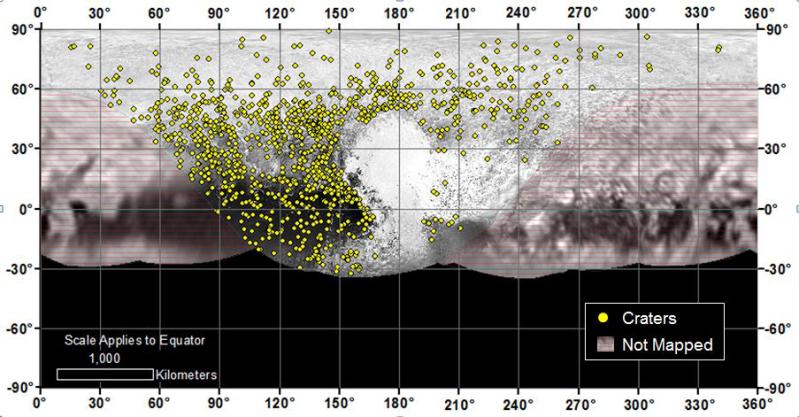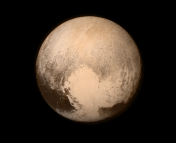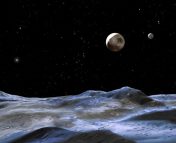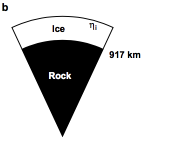Title: The Geology of Pluto and Charon Through the Eyes of New Horizons
Authors: Jeffrey M. Moore, William B. McKinnon, John R. Spencer, et al., including the New Horizons team
First Author’s Institution: NASA Ames Research Center
Status: Published in Science
The New Horizons mission to Pluto and Charon, launched when Pluto was still officially a planet, gave us the best images of the dwarf planet and its largest moon that we might ever see in our lifetime. Less than a year after its July 14, 2015 fly-by, the New Horizons team has published a preliminary geological examination of the two bodies. Predicted to have a rather boring landscape unchanged for billions of years, the surfaces of Pluto and Charon have been discovered to be surprisingly complex and, for Pluto, still geologically active!
Pluto:

Figure 1: An annotated map of Pluto. Credit.
The image of Pluto’s “heart” proved that it still reciprocated our love for it despite its demotion from planetary status. Officially named the “Tombaugh Regio” for Pluto’s discoverer, Clyde Tombaugh, this region actually comprises multiple regions that just have similar coloration and albedo (reflectivity). The left half of the heart is known as the Sputnik Planum, a region the size of Texas and Oklahoma (or, alternatively, France and the United Kingdom). It’s a giant block of solid nitrogen, carbon monoxide, and methane ice that sits about 3-4 km below the surrounding highlands. Amazingly, despite the fact that Pluto was thought to be geologically dead, the Sputnik Planum’s surface is likely <10 million years old based on the fact that no craters have been discovered in the region (see Figure 2). The appearance of cells in the northern half of the Sputnik Planum implies the existence of solid-state convection that may be responsible for resurfacing it.

Figure 2: The distribution of craters on the surface of Pluto. The Sputnik Planum (left half of the heart) contains no craters, implying a surface age of <10 million years. Credit.
The western edge of the Sputnik Planum is marked by multiple, heterogeneous mountain ranges. These mountain ranges have been spectroscopically confirmed to be composed of water ice. These mountains appear to be chunks of a pre-existing surface that have been fractured, moved, and rotated, giving them high elevations and steep slopes. The authors do not know why the mountain ranges exist only on the western edge of the Sputnik Planum.
The portion of the Tombaugh Regio east of the Sputnik Planum (the right half of the heart) comprises flat plains and pitted uplands. These pits are typically a few kilometers across and roughly 1 kilometer deep. Potential glaciers might be breaking off the pitted uplands and flowing into the Sputnik Planum. To the north and northwest of the Sputnik Planum, there are a variety of different terrains, including a washboard (i.e., ridged) terrain, likely formed via erosion, and terrain dissected by networks of deep, wide valleys. To the southwest of the Sputnik Planum are a pair of two huge mounds, only one of which, Wright Mons, was imaged with proper lighting. Wright Mons is 3-4 km high, 150 km across, and has a deep hole right in the center at least 5 km deep. The other mound, Piccard Mons, appears to be even larger. These two mounds are possible cryovolcanoes (i.e., water-ice volcanoes).
The surface of Pluto allows its history to be partially reconstructed. The distribution of crater sizes implies that most of the surface can be dated back to the Late Heavy Bombardment about 3.9 billion years ago. A portion of the Cthulhu Regio, which wins the prize for most creative region name, may even pre-date the Late Heavy Bombardment. The Sputnik Planum, on the other hand, is <10 million years old, although it sits in a much older basin. Its half-ring of mountains to the west suggest that the entire Sputnik Planum might be a giant impact crater.
Charon:

Figure 3: An enhanced color map of Charon. Credit.
Whereas Pluto’s surface is dominated by nitrogen, carbon monoxide, and methane ices, Charon’s surface is mostly water-ice. Charon is rent in half by a pair of gigantic, ancient canyons 50-200 km wide and 5-7 km deep that split the moon (or maybe binary dwarf planet) into two general regions. The northern half displays a network of large troughs 3-6 km deep. A massive depression nearly 10 km deep (seen in profile as the bumpy edge against the black of space in Figure 3) lies near the Mordor Macula, the reddish cap on the north pole. Meanwhile, the Dorothy Gale crater located to the bottom and right of the Mordor Macula is 230 km wide and 6 km deep. The overall crater population distribution implies that the northern half of Charon is about 4 billion years old.
By contrast, the southern half of Charon is smoother and slightly younger by maybe a few hundreds of millions of years. A lower density of craters and fields of small hills point to past cryovolcanism. A feature unique to Charon is its mountains that rise 3-4 km above encircling moats. The moats themselves are 1-2 km below the surrounding surface, potentially due to the mountains pressing the surrounding region deeper into the moon.
The Future of New Horizons:
This is only the beginning. It’s been just 9 months since New Horizons careened past Pluto and Charon. A data transfer rate of just 1-2 kb/s means we won’t even have all the data for another 7 months! New Horizons isn’t finished yet either. It plans to study several Kuiper Belt objects from afar and will even perform a close fly-by of one, 2014 MU69, on January 1, 2019, for NASA’s own version of a New Year’s fireworks display.





Trackbacks/Pingbacks